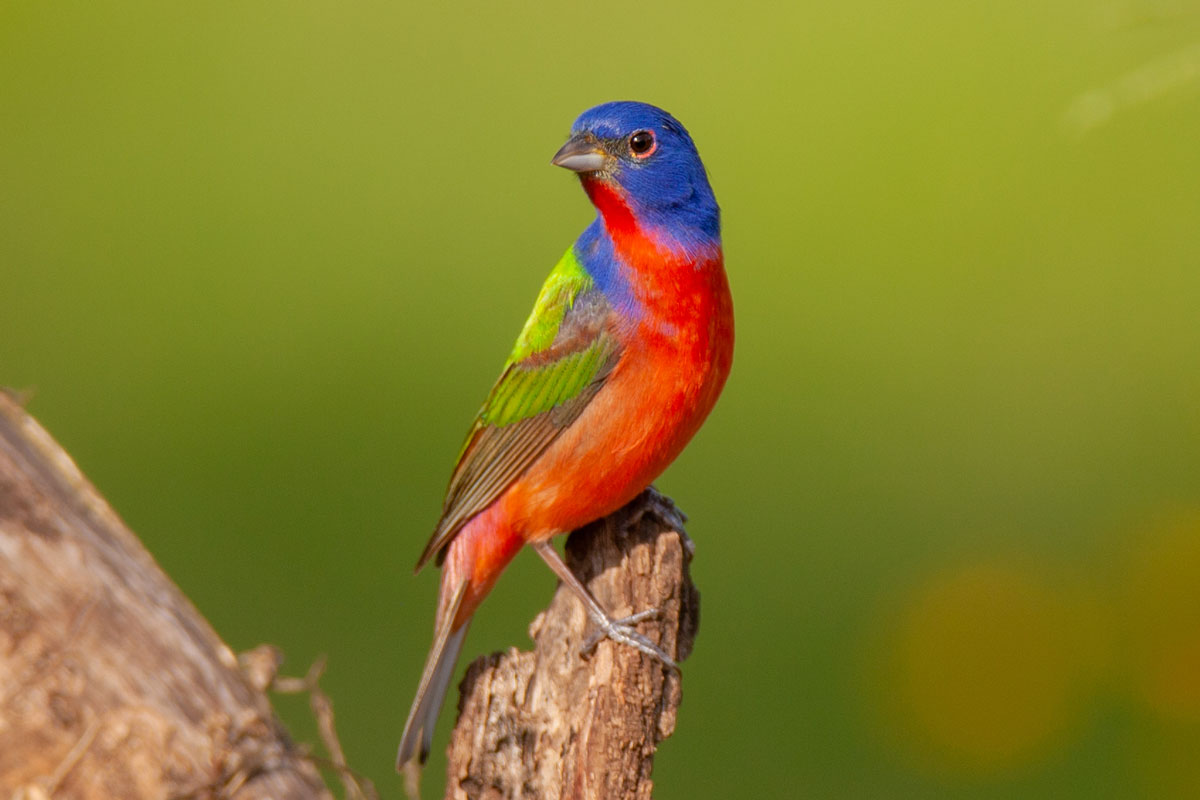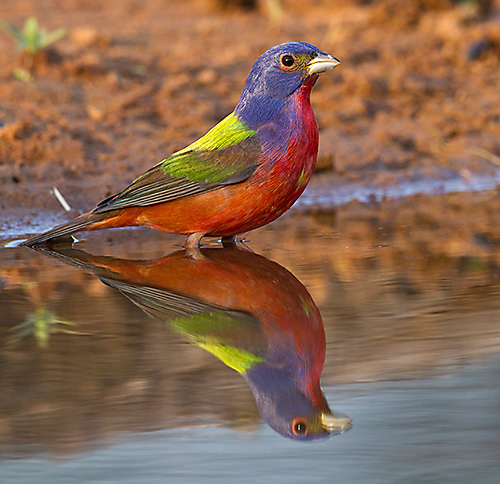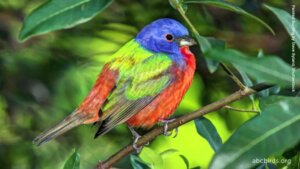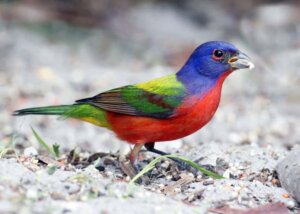Painted Bunting Facts: Discover the Secrets of This Colorful Bird
The painted bunting is a vibrant and colorful bird. It captivates bird watchers and nature lovers alike.
This small songbird, often called a “flying rainbow,” is found primarily in the southeastern United States during its breeding season. With its striking plumage, the painted bunting easily stands out among other birds. Males flaunt a dazzling mix of blue, green, and red, while females and juveniles sport a more subdued green and yellow hue.
Painted buntings thrive in brushy areas, open woodlands, and gardens. Knowing more about their habits and life cycle can enhance your bird-watching experience. This blog will explore fascinating facts about these beautiful birds, shedding light on their behavior, habitat, and unique characteristics. So, let’s dive into the colorful world of painted buntings!

Credit: www.lyricbirdfood.com
Introduction To Painted Buntings
The Painted Bunting is a stunning bird. It captivates birdwatchers and nature lovers alike. Known for its vibrant colors, this small bird is a visual treat. Its scientific name is Passerina ciris. Despite its beauty, the Painted Bunting remains elusive to many. It often hides in thick foliage, making sightings rare. This mysterious nature adds to its charm and allure.
Brief Overview
The male Painted Bunting is a spectacle of colors. It boasts a blue head, green back, and red underparts. Females and young birds are green and yellow. These birds are native to North America. They breed in the southeastern United States and migrate to Central America in winter. Painted Buntings prefer habitats like gardens, thickets, and woodland edges.
Significance In Birdwatching
Birdwatchers treasure the Painted Bunting. Its colorful plumage makes it a prized sighting. Spotting this bird is a highlight for many enthusiasts. The Painted Bunting also helps in attracting new birdwatchers. Its beauty often sparks an interest in birdwatching. Conservation efforts aim to protect their habitats. This ensures birdwatchers can enjoy these stunning birds for years to come.

Credit: www.perkypet.com
Physical Characteristics
The Painted Bunting is often called a living rainbow. Its physical characteristics make it one of the most striking birds in North America. These features help it stand out in the wild, making it a favorite among bird watchers.
Vibrant Colors
Male Painted Buntings boast bright colors. They have blue heads, red underparts, and green backs. These vibrant colors help males attract mates. Females, on the other hand, are bright green all over. This color helps them blend into their surroundings.
Size And Shape
Painted Buntings are small songbirds. They measure around 5-6 inches in length. Their wingspan is about 8-9 inches. They have short, thick beaks. These beaks are perfect for cracking seeds. The body shape is plump and the tail is short.
Habitat And Distribution
The Painted Bunting is a stunning bird known for its vibrant colors. Understanding its habitat and distribution can help bird enthusiasts find and observe this beautiful species. Below, we delve into where these birds thrive and where you might spot them.
Preferred Environments
Painted Buntings prefer dense, shrubby areas. They thrive in habitats with plenty of cover. This includes thickets, brushy fields, and woodland edges. They also favor areas near water sources.
In the breeding season, they look for open spaces with scattered shrubs. These areas provide food and nesting sites. During the winter, they seek dense, tropical forests. These environments offer protection and abundant food.
Geographical Range
The Painted Bunting’s range spans across North and Central America. In the United States, they are found in the southeastern regions. This includes states like Texas, Florida, and Georgia.
During the breeding season, they migrate north. They reach as far as North Carolina and Kansas. In the winter, they move south to Mexico and Central America. Some even reach as far as Panama.
Their migration patterns are predictable. This makes it easier for bird watchers to plan sightings. Knowing their geographical range helps in understanding their seasonal movements.
Diet And Feeding Habits
The painted bunting is one of the most colorful birds in North America. Their diet and feeding habits are interesting and diverse. Understanding what they eat and how they feed can help in attracting these beautiful birds to your backyard.
Common Foods
Painted buntings have a varied diet. They eat seeds, insects, and berries. Below is a table highlighting their common foods:
| Food Type | Examples |
|---|---|
| Seeds | Grass seeds, millet, sunflower seeds |
| Insects | Spiders, caterpillars, beetles |
| Berries | Blackberries, elderberries, blueberries |
Feeding Behavior
Painted buntings forage both on the ground and in vegetation. They are often seen hopping on the ground, picking up seeds. Sometimes, they catch insects mid-air.
During breeding season, their diet shifts more towards insects. The extra protein helps their chicks grow. They are less social when feeding. Males are territorial and protect their feeding areas.
Setting up a bird feeder with seeds can attract them. Also, planting berry bushes will provide natural food sources. Remember to keep the feeding area clean to avoid diseases.
Breeding And Nesting
Painted Buntings are small, colorful birds known for their unique breeding behaviors. Breeding and nesting are crucial parts of their life cycle. Understanding these behaviors can provide insights into their survival and reproduction strategies.
Mating Rituals
Male Painted Buntings perform elaborate displays to attract females. They sing melodious songs while perched on branches. These songs help establish territory and impress potential mates. The males also engage in flutter flights, showing off their vibrant plumage. This visual display is crucial in gaining the female’s attention.
Nest Construction
Female Painted Buntings take the lead in nest building. They choose a hidden spot in dense vegetation. The nests are usually low to the ground, offering protection from predators. Females use grass, leaves, and spider webs to construct the nest. The final structure is a small, cup-shaped nest, well-hidden from view. Once the nest is complete, the female lays three to four eggs. She incubates the eggs while the male guards the territory.

Credit: www.youtube.com
Conservation Status
The Painted Bunting is a colorful bird admired by many. Its vibrant plumage makes it a favorite among bird watchers. But the conservation status of the Painted Bunting reveals a darker story. This bird faces numerous threats and challenges that jeopardize its survival. Let’s take a closer look at what is being done to protect this beautiful species.
Threats And Challenges
Painted Buntings face several threats in the wild. Habitat loss is the most significant threat. Urbanization and agriculture destroy their natural habitats. Illegal trapping for the pet trade also endangers these birds. Another issue is climate change. It alters their migratory patterns and breeding grounds.
Predation is another challenge. Cats and other predators pose a risk to Painted Buntings. Additionally, pollution affects their health. Chemicals in the environment can poison their food sources. These threats combine to make life difficult for these colorful birds.
Protection Efforts
Many organizations are working to protect the Painted Bunting. Conservation groups focus on habitat preservation. They work to protect areas where these birds live and breed. Educating the public is also important. Awareness campaigns help people understand the importance of protecting these birds.
Legislation plays a crucial role. Laws against illegal trapping and trading are enforced. Protected areas are established to ensure safe habitats. Climate action is also crucial. Reducing pollution and mitigating climate change helps preserve their environment. These efforts are essential for the survival of the Painted Bunting.
| Threat | Impact |
|---|---|
| Habitat Loss | Destroys breeding grounds |
| Illegal Trapping | Reduces population numbers |
| Climate Change | Alters migratory patterns |
| Predation | Increases mortality rates |
| Pollution | Poisons food sources |
Conservation efforts are ongoing, but more work is needed. Protecting the Painted Bunting requires a multi-faceted approach. Everyone can help by supporting conservation initiatives and spreading awareness. Together, we can ensure the survival of this stunning bird.
Frequently Asked Questions
What Is A Painted Bunting?
A Painted Bunting is a small, colorful songbird found in North America. Males are known for their vibrant, multi-colored plumage.
Where Do Painted Buntings Live?
Painted Buntings inhabit the southeastern United States, Central America, and the Caribbean. They prefer brushy areas and woodland edges.
What Do Painted Buntings Eat?
Painted Buntings primarily eat seeds and insects. They forage on the ground and in bushes for food.
How Long Do Painted Buntings Live?
Painted Buntings typically live for about five to ten years in the wild. Their lifespan can vary based on environmental factors.
Conclusion
Painted Buntings are truly fascinating birds. Their vibrant colors captivate nature lovers. Observing them can be a delightful experience. These birds thrive in various habitats. They eat seeds, insects, and fruits. Birdwatchers often seek them eagerly. Now, you know key facts about Painted Buntings.
Enjoy spotting these beautiful creatures. Their presence adds magic to nature. Explore, observe, and cherish these avian wonders. Happy birdwatching!
Hello Dear, I'm Poli Kolymnia, owner of many birds (including budgies).
With a deep passion for these feathered companions, I'm here to share my expertise and extensive knowledge on birds care.
My articles cover essential topics like diet, housing, care, and health, providing practical tips to help you create a happy and thriving environment for your birds.



